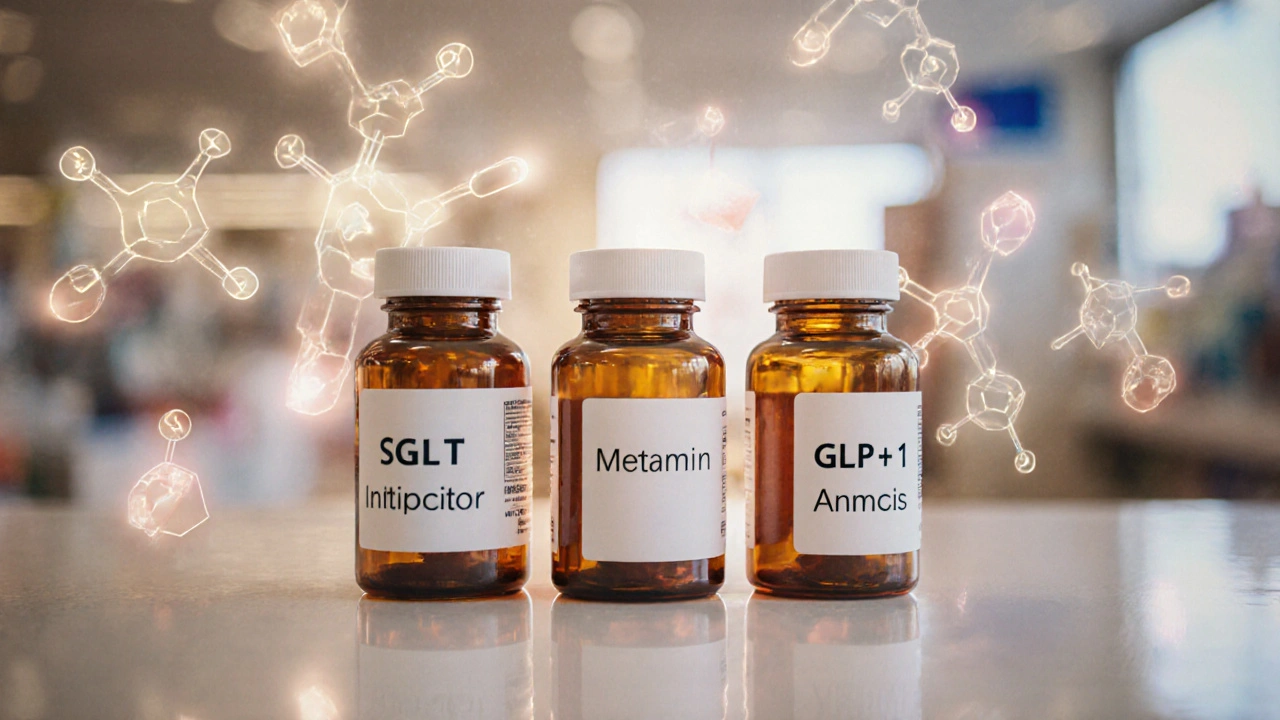
Dapasmart (Dapagliflozin) Suitability Checker
This tool helps determine if Dapasmart might be a suitable option based on key clinical factors.
Quick Take
- Dapasmart (dapagliflozin) is a once‑daily SGLT2 inhibitor that lowers blood sugar by pushing excess glucose out through urine.
- It offers modest weight loss and blood‑pressure reduction, but carries a risk of genital infections.
- Compared with empagliflozin and canagliflozin, dapagliflozin has a slightly lower cardiovascular‑outcome benefit but a similar safety profile.
- When stacked against non‑SGLT2 drugs like metformin or GLP‑1 agonists, dapagliflozin is less potent for A1C reduction but shines in simplicity and kidney protection.
- Choosing the right agent depends on A1C target, kidney function, cardiovascular risk, and patient preference for injection vs. oral therapy.
What Is Dapasmart?
When you first see the name Dapasmart is a brand name for dapagliflozin, a member of the SGLT2 inhibitor class. It works by blocking the sodium‑glucose co‑transporter‑2 in the kidney, which prevents glucose reabsorption and forces excess sugar out in the urine. The result is lower plasma glucose, mild diuresis, and a drop in systolic blood pressure.
How Dapasmart Stacks Up Against Other SGLT2 Inhibitors
Three other SGLT2 inhibitors dominate the market: empagliflozin, canagliflozin, and ertugliflozin. They all share the same mechanism but differ in dosing, cardiovascular outcomes, and renal thresholds.
| Drug | Typical dose | Avg. A1C reduction | Weight loss (kg) | Cardio benefit* | Key safety notes |
|---|---|---|---|---|---|
| Dapasmart (dapagliflozin) | 10mg daily | ≈0.7% | ≈1.5 | Modest (non‑inferior to placebo in major‑MACE) | Genital yeast infections, volume depletion |
| Empagliflozin | 10-25mg daily | ≈0.8% | ≈2.0 | Significant MACE reduction (EMPA‑REG OUTCOME) | Similar infection risk, rare ketoacidosis |
| Canagliflozin | 100-300mg daily | ≈0.8-0.9% | ≈2.2 | Reduced MACE and renal events (CANVAS) | Higher amputation signal at 300mg |
| Ertugliflozin | 5-15mg daily | ≈0.7% | ≈1.7 | Neutral on MACE, modest renal benefit | Standard SGLT2 safety profile |
*MACE: major adverse cardiovascular events (heart attack, stroke, cardiovascular death).
Dapasmart vs. Non‑SGLT2 Options
Most patients start with metformin, an oral biguanide that reduces hepatic glucose production. Metformin can lower A1C by 1.0-1.5% but does not aid weight loss and has no proven cardiovascular benefit beyond modest risk reduction.
For those needing extra potency, injectable GLP‑1 receptor agonists such as semaglutide provide 1.2-1.8% A1C drop, 3-5kg weight loss, and strong cardio‑protective data. The downside? Weekly or daily injections, higher cost, and gastrointestinal side‑effects.
When you compare dapagliflozin to these classes, you see a trade‑off:
- Potency: Metformin > Dapasmart; GLP‑1 > Dapasmart.
- Weight impact: Dapasmart modestly reduces weight; GLP‑1 does more; metformin is weight neutral.
- Cardio/renal protection: Dapasmart offers renal benefit and a mild cardio signal, whereas metformin’s effect is indirect and GLP‑1 has the strongest evidence.
- Convenience: Dapasmart and metformin are pills; GLP‑1 requires injection.

When to Prefer Dapasmart
Consider dapagliflozin if you meet any of these scenarios:
- Baseline eGFR is 30-60mL/min/1.73m² - dapagliflozin retains efficacy where many other agents lose potency.
- You want a simple once‑daily oral option without the gastrointestinal upset that comes with GLP‑1 drugs.
- Weight loss is a modest but desirable goal (≈1-2kg over 6months).
- Blood‑pressure reduction (3-5mmHg) would complement your overall risk‑management plan.
Patients with recurrent genital infections, a history of severe ketoacidosis, or on dialysis should avoid SGLT2 inhibitors, including dapagliflozin.
Practical Tips for Starting Dapasmart
- Check kidney function (eGFR) before prescribing; continue if ≥30mL/min/1.73m².
- Educate patients to stay hydrated and report any foul‑smelling urine or persistent yeast infections.
- Monitor A1C at 3‑month intervals; expect a 0.5-0.8% drop when combined with metformin.
- If a patient is on a sulfonylurea, consider dose reduction to avoid hypoglycemia once dapagliflozin kicks in.
- For patients planning surgery or prolonged fasting, hold dapagliflozin 3 days before to prevent euglycemic ketoacidosis.
Bottom Line: How Dapasmart Measures Up
In a head‑to‑head view, dapagliflozin lands in the middle of the SGLT2 pack. It isn’t the most aggressive cardio‑winner (that’s empagliflozin) nor the most potent A1C reducer (canagliflozin at high dose). Its sweet spot is a reliable oral drug that works well in patients with mild‑to‑moderate kidney impairment, offers modest weight loss, and adds a safety cushion for heart‑failure patients.
If you need a drug that’s easy to swallow, works in a broad eGFR range, and carries a low risk of severe side‑effects, dapagliflozin is a solid choice. Pair it with metformin for first‑line therapy, or use it as a second‑line add‑on when GLP‑1 agonists feel too invasive.
Frequently Asked Questions
Can I take Dapasmart if I have stage 3 chronic kidney disease?
Yes, dapagliflozin is approved down to an eGFR of 30mL/min/1.73m². Below that, the glucose‑lowering effect wanes and the drug is usually stopped.
How does Dapasmart compare to semaglutide for weight loss?
Semaglutide typically yields 3-5kg of loss over a year, while dapagliflozin delivers about 1-2kg. If weight loss is a primary goal and injections are acceptable, semaglutide is superior.
Do I need to stop Dapasmart before surgery?
Most guidelines suggest holding the drug at least 48-72hours before major surgery to reduce the risk of euglycemic ketoacidosis.
What are the most common side‑effects?
Genital yeast infections (especially in women), urinary tract infections, and mild dehydration are the top three reported events.
Is Dapasmart covered by most insurance plans?
Because dapagliflozin is on most formularies, generic versions are usually covered, but exact copay varies by plan and region.
Comments (19)
-
Rahul Kr September 30, 2025
Looks like a solid oral option for those with modest kidney issues 😊.
-
Anthony Coppedge October 2, 2025
From a grammatical standpoint, the article is well‑structured; however, there are a few nuances worth noting. Dapagliflozin’s modest cardiovascular benefit, while not as pronounced as empagliflozin’s, still provides a clinically relevant edge. The renal protection data, especially at eGFR thresholds of 30‑60 mL/min/1.73 m², make it a viable second‑line choice. Moreover, the weight‑loss potential, albeit modest, can be a deciding factor for patients reluctant to start injectable therapy.
-
Joshua Logronio October 5, 2025
Yo, have you ever thought that the pharma bigwigs are secretly swapping out the real cure for a sugar‑pumping placebo? I mean, dapagliflozin looks legit but who’s really benefitting when they push pills that just make you pee out glucose. Anyway, just a thought, keep an eye out.
-
Nicholas Blackburn October 7, 2025
Dapagliflozin is overrated; the so‑called “modest weight loss” is nothing more than a marketing gimmick, and the genital infection risk is under‑reported. Patients are being fed a half‑truth while doctors overlook the higher ketoacidosis potential in high‑risk groups. If you want real numbers, look beyond the glossy tables. Stop pretending this drug is a panacea.
-
Dave Barnes October 9, 2025
In the grand theater of metabolic regulation, dapagliflozin plays the humble understudy to empagliflozin’s starring role. Yet, its quiet entrance into the renal corridor whispers a paradox: simplicity can mask profundity. When choosing a glucose‑lowering agent, one must weigh not only HbA1c percentages but also the poetry of patient adherence. So, perhaps the “middle‑ground” drug carries its own quiet wisdom.
-
Kai Röder October 11, 2025
For clinicians navigating the expanding SGLT2 landscape, dapagliflozin offers a balanced profile that aligns well with patients seeking oral therapy and modest renal benefit. Initiating treatment at an eGFR of 30 mL/min/1.73 m² is acceptable, but ensure adequate hydration and monitor for genital infections. Pairing it with metformin can achieve a synergistic A1C reduction of roughly 0.8 %. Tailor the choice to individual risk factors and lifestyle preferences.
-
Brandi Thompson October 13, 2025
Dapasmart presents a compelling case for patients who prioritize an oral regimen over injectable options. Its mechanism of increasing urinary glucose excretion directly addresses hyperglycemia without relying on insulin pathways. The modest weight loss observed in clinical trials adds an ancillary benefit that many patients find appealing. Safety concerns such as genital mycotic infections are manageable with proper patient education. Kidney protection emerges as a notable advantage especially in those with stage 3 chronic kidney disease. Cardiovascular outcomes, while not as robust as empagliflozin, still demonstrate a non‑inferior risk profile. The drug’s once‑daily dosing simplifies adherence compared to multiple daily pills. Cost considerations vary but generic versions improve accessibility in many formularies. Real‑world data suggest that dapagliflozin can be combined safely with metformin and, when needed, a GLP‑1 agonist. Monitoring eGFR periodically ensures ongoing suitability especially as renal function declines. Patients should be counseled to maintain adequate fluid intake to mitigate dehydration risks. The risk of euglycemic ketoacidosis remains low but warrants vigilance during fasting or surgical periods. Overall the benefit‑risk balance favors use in a broad patient population. Clinicians should individualize therapy based on cardiovascular risk, weight goals, and kidney function. In summary dapasmart fills a niche between highly potent SGLT2 inhibitors and more traditional oral agents.
-
Chip Hutchison October 14, 2025
When we think about global diabetes care, accessibility and cultural relevance become just as important as efficacy. Dapagliflozin’s oral form can be especially helpful in regions where injectable therapies face barriers due to stigma or supply issues. Educating patients about hydration and infection signs in their native language improves outcomes. Moreover, integrating dapagliflozin with diet advice that respects local cuisines can enhance adherence. It’s a small piece of a larger puzzle, but one that fits nicely for many.
-
Tim Ferguson October 16, 2025
I see the hype around dapagliflozin and wonder if we’re overlooking cheaper options that work just as well. Maybe the focus on cardio benefits distracts from basic glucose control.
-
Noah Cokelaere October 18, 2025
Oh great, another pill that promises you’ll lose a kilo while you’re busy scrolling Reddit. If only it could also sort out my inbox, we’d be set.
-
Ashley Helton October 20, 2025
Sure, dapagliflozin sounds like the perfect “just add water” solution-because we all have time to monitor my sugar‑laden urine, right?
-
Brian Jones October 21, 2025
Honestly, the data on dapagliflozin are solid; the A1C drop may be modest-but in the grand scheme of patient‑centered care, even a 0.7% reduction can translate to meaningful quality‑of‑life gains; remember, every percentage point counts when you’re battling chronic disease, and the added renal protection is a bonus you shouldn’t ignore.
-
Johnson Elijah October 23, 2025
Let’s be real – dapagliflozin isn’t the superstar, but it’s a reliable sidekick in the diabetes saga 💪. Use it when you need oral convenience and a little kidney love.
-
christopher werner October 24, 2025
Appreciate the balanced overview; useful for clinicians weighing options.
-
Travis Evans October 26, 2025
Yo, dapagliflozin’s like that steady homie who shows up to the party late but still brings the good vibes. Not flash, but it gets the job done.
-
Jessica Hakizimana October 27, 2025
Feeling hopeful about dapagliflozin’s role, especially for patients who want a simple pill with added heart and kidney perks. Keep spreading the good news!
-
Keyla Garcia October 28, 2025
Honestly, the whole “modest weight loss” claim feels like a plot twist in a bad soap opera 🙄. If you’re looking for results, maybe aim higher.
-
Ismaeel Ishaaq October 30, 2025
Bro, have you checked the latest African cohort data? Dapagliflozin actually shines in our population, cutting down hospital admissions like a champ! Let’s push this info to the frontlines now.
-
Jesse Goodman October 31, 2025
Dapagliflozin works well, especially for kidney health 😊.
